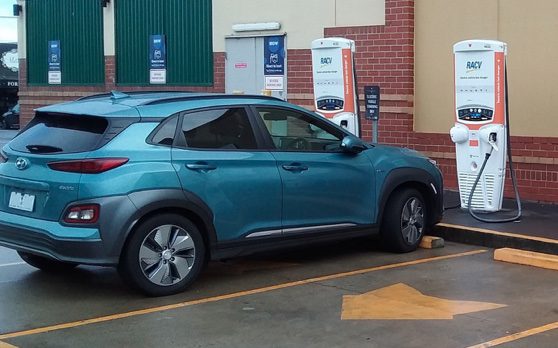Fossil fuel station forecourts have long been laid out with at least a nod to disability access. Flat areas around the pumps, waist-height access to the nozzles, vertical bollards beside the pumps, gentle ramps to the shop rather than steps – oh, and pull-through parking spots beside the pumps so you can best align the car next to the fuel pump. (Only to realise you’ve parked with the car’s filler on the other side ;-).
At least, where it comes to fossil fuel pumps, all-ability driver access is there for the pump body, filling nozzle and paying at the counter.
However, it seems EV charging has a lot to learn from the fossil fuel station in terms of accessibility.
First-up: perpendicular parking with the EVSE at one end is the norm – meaning you have to drive or reverse in rather than pull up beside it – and hope the lead will reach the socket.
Next – you will almost always find the EVSE on the other side of a raised gutter and/or other barrier – commonly including a raised buffer on the road between the car and charger.
Even at the rare charging station where the EVSE is positioned at the side of the EV, it is often found on a raised plinth and/or the combination of the car charging socket and charger lead length prevents you parking properly in the allocated space.

Once the car socket is positioned within cooee of the EVSE lead, getting out of the car can be a trial even for those not living with a disability.
Often, positioning the car requires parking close to a hurdle course of leads dangling on the ground, bollards and raised kerbs – let alone other cars parked in adjacent spots. So spare a thought for those who need access to open the door fully, have clear ground to move around or need to climb through the aforementioned potential obstacle course to access the user interface of the charger.

Note: kerb and tyre buffer between car and charger, right hand side lead on charger an obstacle, if a second car was to pull alongside the car door would not be able to be fully opened, etc.
Charger accessibility firmly on the radar in Europe and north America
Overseas, the EV Transition has gained enough pace now for more than a few to notice these problems. As a result, charger accessibility has started moving to the forefront of authorities’ minds.
One example is the UK: with the move there to ban sales of new internal combustion engine (ICE) cars and vans from 2030, both a significant network of EV chargers will need to be installed … along with the need for a predicted 2.7 million disabled drivers potentially needing to use them!
To tackle the issue of EV charger accessibility, Publically Available Standard (PAS) 1899:2022 Electric vehicles – Accessible charging – Specification is to be released this coming October. (Publicly Available Standards by the way are the UK system for quickly developing a national standard to address a recently identified need).
PAS 1899:2022 has been developed to define the requirements for creating accessible public car charging to all potential users. (For example, disabled people and older people).
To quote from the introduction to the PAS: “The provision of clear standards on how to install more inclusively designed chargepoints is expected to improve the experiences of disabled people using public chargepoints, and can increase public engagement and confidence in the future of electric vehicle charging”.
The UK is not alone, however. The EU is looking into the issue, plus the US Access Board (an independent federal agency that issues accessibility guidelines) has also recently issued guidelines for EV charging stations. Their document applies to the technical requirements for things such as floor and ground surfaces, clear floor or ground space, reach ranges, operable parts, accessible routes and more. That document can be found here.
Examples of accessible EV charging abound
Examples of businesses recognising the need for accessible EV charging also abound. One from the UK is Urban Electric and their pop-up kerbside EV charger. In order to make their EV charger more easily reached (for example, by someone in a wheelchair), their app now includes the ability to set the height it pops up to.
Another example comes from Canada, where BC Hydro are working to not only ensure all their new EV charging sites are designed to be fully accessible, they intend to retrofit their existing locations over the next three years.
These accessibility changes include wider parking stalls, paved access, lowered screens and cables, wider spaced protective bollards, improved lighting and better signage. (Interestingly, BC Hydro also plan to start building pull-through sites that are designed to accommodate larger electric trucks and vehicles with trailers).
BC Hydro are not the only EV charger supplier in Canada doing this though: Hydro-Québec are also working along similar lines to improve the accessibility of their EV charging sites.
Meanwhile, in Australia…
Here in Australia, my experience has been that public EV charging installations so far have been a rather ad-hoc affair. However, being an EV adoption laggard does have its advantages: as shown above, we have lots of overseas examples to learn from.
Perhaps the biggest lesson though is the reminder that the EV Transition is broader than just swapping electric cars for fossil fuelled ones – and we need to plan sooner rather than later if we are to make that transition a smooth and inclusive one.

Bryce Gaton is an expert on electric vehicles and contributor for The Driven and Renew Economy. He has been working in the EV sector since 2008 and is currently working as EV electrical safety trainer/supervisor for the University of Melbourne. He also provides support for the EV Transition to business, government and the public through his EV Transition consultancy EVchoice.

